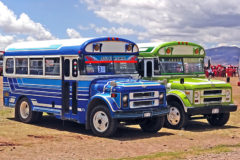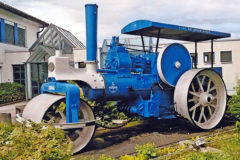British Atlantic intermediate liner Cameronia
Posted by Chris Graham on 9th July 2021
One hundred years on, Peter C Kohler recalls the British Atlantic intermediate liner Cameronia, the first to be built after World War I.
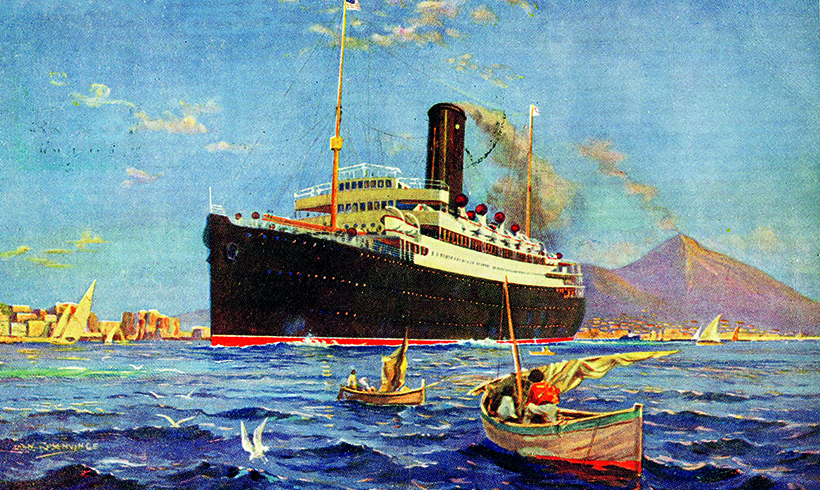
British Atlantic intermediate liner Cameronia: This early portrait of Cameronia/Tyrrhenia, by Odin Rosenvinge, has a background of Naples and Mount Vesuvius, suiting their originally intended Mediterranean-New York route. In the end, Tyrrhenia was completed for Cunard and Cameronia operated on the Glasgow-New York run. (Pic: Author’s collection)
Anchor Line, owned by Cunard since 1911, lost three of its largest liners during World War I, leaving only Columbia (1902) to resume Glasgow-New York sailings in August 1919. An ambitious new building programme comprised Cameronia, ordered from Beardmores, Caledonia and Transylvania from Fairfields, and California and Tuscania from Alex. Stephens for the Glasgow and Mediterranean to New York routes.
Laid down at Dalmuir on March 7th, 1919, as yard No. 584, Cameronia was the first new, post-war British liner, and the first of 34 ships totalling 389,000grt ordered for Cunard and associated lines.
Designed by Cunard’s naval architect, Leonard Peskett, and setting the pattern for the 1920s intermediate liners, Cameronia measured 16,243grt with a length of 578ft and beam of 70.4ft. Driving twin screws, 12,500shp Brown-Curtis double-reduction geared turbines and three double-ended and three single-ended, oil-fired 220psi boilers, gave her a 16.5-knot service speed. Seven holds, four forward and three aft, had a 400,000ft3 (bale) and 29,000ft3 (reefer) capacity.
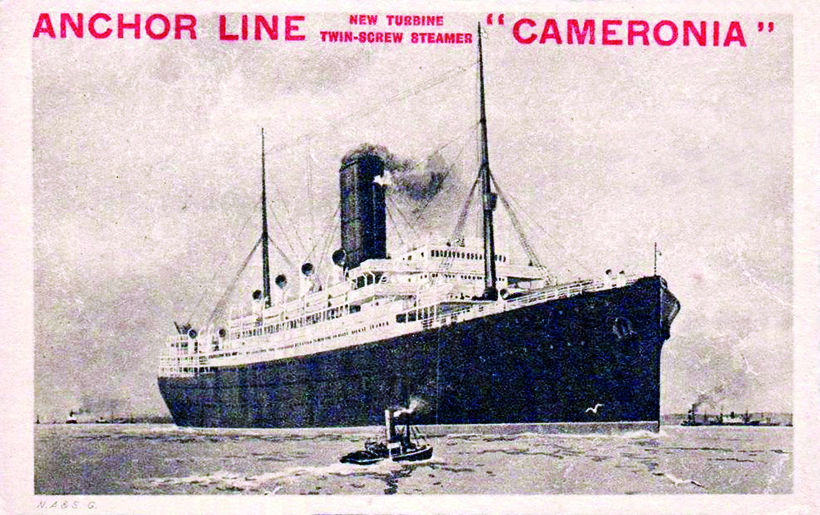
The first official Anchor Line card for the new Cameronia. What appears to be the world’s smallest tugboat is depicted for ‘scale’ purposes. (Pic: Author’s collection)
First class for 256 occupied the topmost three decks amidships, with two- and three-berth cabins, some with private bath, with a drawing room, writing room, smoke room, gymnasium and veranda café on the Promenade Deck. Second class for 370 was aft of First, with two- and four-berth cabins and a lounge and smoke room. Third class for 1,150 was fore and aft with two-, four- and six-berth cabins, two dining saloons, a general room and smoke room.
Cameronia was launched on December 23rd, 1919, by Lady Hermione Cameron of Lochiel, but her completion was badly delayed by strikes. A joiners’ strike postponed her intended February 16th, 1921, maiden voyage, then that of April 16th. After trials on March 9-10th, she sailed to Cherbourg for completion of her interiors. In the event, her first voyage began from Liverpool on May 11th, on Cunard’s service to Halifax and New York. Heavy fog delayed her Halifax arrival by a day and Cameronia docked at New York on May 21st.
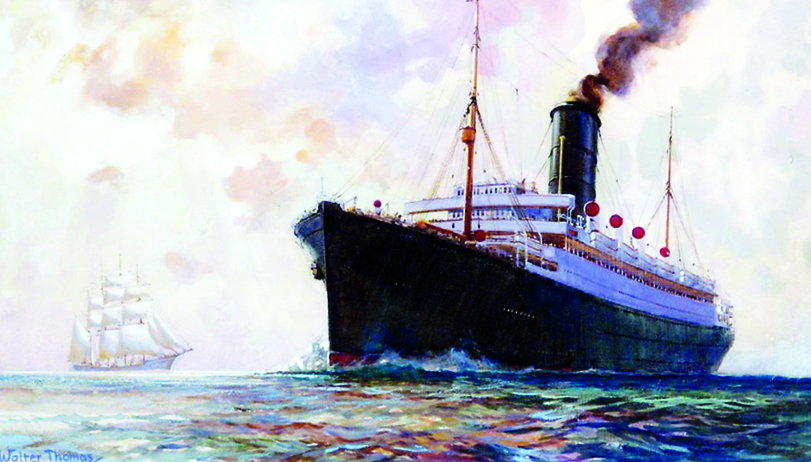
The new Anchor liner as depicted by Walter Thomas. JH Isherwood wrote ‘Cameronia was one of the finest looking of the smaller North Atlantic liners. She had a high sheer forward and a tremendous flare, while the hull dropped away gracefully to a very neatly-shaped cruiser stern . . . giving her a stately and dignified character.’ (Pic: Author’s collection)
Cameronia joined Anchor’s New York-Glasgow service on June 1st, 1921. On November 19th she sailed from New York for Madeira, Gibraltar, Monaco, Genoa and Naples. The round voyage was sold as a cruise by Thos. Cook, who chartered her in 1922 for a 63-day Mediterranean cruise from New York, from July 5th to September 6th. Otherwise, she stayed full-time on the Glasgow-New York run. New to her routine, starting on March 26th,1923, were occasional Boston calls; three years later it became a regular stop when she was en route to/from New York.
On October 13th, 1925, Cameronia rescued the crew of the US Coast Guard patrol boat CG-128, which was disabled off Nantucket in a ferocious storm. When she sailed from Glasgow on January 2nd, 1926, steering gear problems forced the liner’s return four days later. Her voyage was cancelled so she could be repaired, and her passengers were transferred to Laconia.
In late November, 1928, Cameronia arrived at Beardmore’s, where the forepart of her hull was rebuilt to reduce pitching in head seas, caused by a too flat-bottomed profile. Not only had this proved uncomfortable for passengers, but it also occasioned expensive repairs, so much so that her underwriters paid half the £44,000 cost. A new bow section with finer lines, measuring 170ft by 24ft, was built at D&W Henderson’s yard and then dismantled, with every plate, rib and bolt numbered. In five weeks, the original hull section was cut out and the new section reassembled in its place. Her now dated Third Class public rooms were also improved.
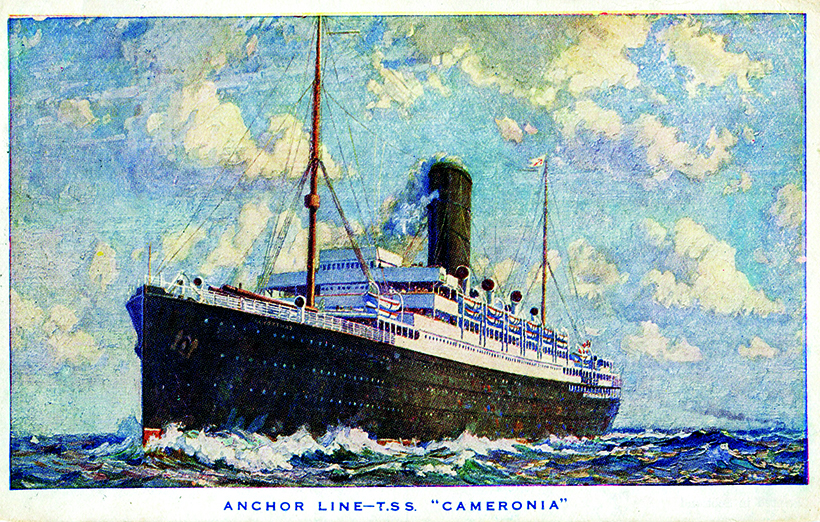
An early postcard depiction of Cameronia at sea, issued by Anchor Line; she was managed by the Henderson Brothers Ltd.
The improved Cameronia returned to New York on March 6th, 1929, and the next month inaugurated calls at Belfast, alternating with those at Moville (for Londonderry). Starting in June, she accommodated 290 Cabin, 431 Tourist Third and 698 Third Class passengers. On May 24th, 1930, an explosion aboard City of Sydney in the Irish Sea killed one man and injured three, and Cameronia answered her SOS and transferred the casualties to Belfast.
For National Tours, Cameronia sailed from New York to Bermuda on April 3rd, 1932, and to Havana on August 15th, and these proved to be her only one-class cruises. Cameronia’s December 14th-23rd, 1932, crossing saw 400 of her 717 passengers stricken with influenza. Her surgeon was on 24-hour duty for four days, making 500 visits a day treating the sick, none of whom died and most of whom had recovered by the time the ship docked at Glasgow.
Cameronia, eagerly awaited, docked at New York on December 11th, 1933, with the first shipment of 40,000 cases of Scotch whisky since the end of prohibition. This was followed by a record 103,623 cases, landed on February 5th, 1934. Cameronia docked at Glasgow on August 21st, 1934, with ‘her decks battered, her furniture splintered and 30 of her passengers suffering from injuries after being hurled across her cabins from 60ft waves’. During the two-day gale, one seaman was washed overboard and lost.
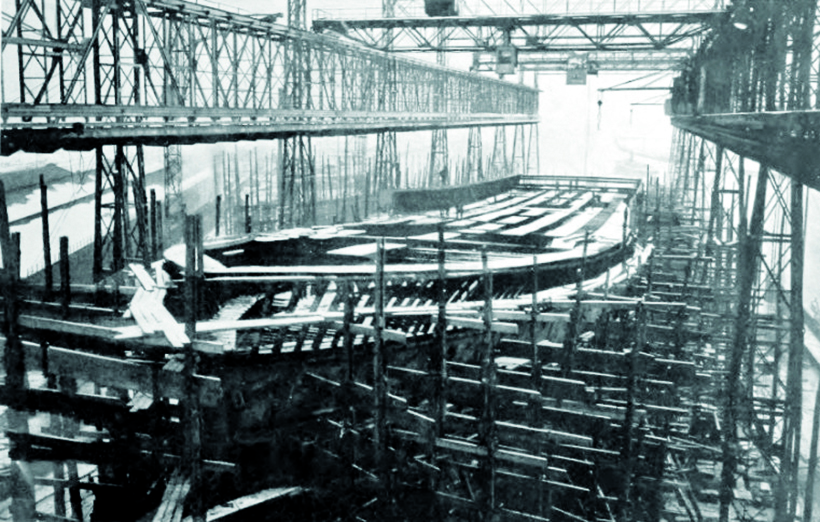
Cameronia on the ways at Beardmore’s, Dalmuir yards in 1919. She was the very first post-war British liner. (Pic: Shipbuilding & Shipping Record, 1920)
With Anchor Line’s traffic devastated by the Depression, Cameronia was laid up in King George V dock, Shieldhall in late December, 1934. The following May, the line went into receivership and was reformed and refinanced under Runciman Ltd, ending the Cunard association.
The British military build-up following the Italy-Abyssinia War saw Cameronia chartered as a transport. She left Glasgow on October 3rd, 1935, and thence from Liverpool with 2,000 troops for Aden. On March 1st, 1936, she arrived at Southampton from India four days late owing to propeller problems. Nine days later she sailed on her final trooping voyage to Sudan. In six months, Cameronia carried 16,617 personnel on four voyages, to Aden, Singapore, Bombay and Port Sudan.
Cameronia entered Barclay, Curle’s Elderslie yards, on April 23rd, 1936, for a £30,000 refit, before resuming her New York run amid better trading conditions. Her machinery was overhauled, her boilers were fitted with super heaters and Tourist Class cabins were provided with hot and cold running water. She returned to service with a July 11th Glasgow sailing.

The only sisterships in the British Merchant Navy to serve under different owners: Tyrrhenia (left) and Cameronia (right) at Dalmuir, May 1920. Their completion was already badly delayed by strikes.
The Admiralty chartered Cameronia from May 18th to the 22nd, 1937, for the Coronation Fleet Review at Spithead, during which she carried invited guests. On February 5th, 1938, she returned to service after a refit, with all her Third class cabins now provided with running water and wardrobes.
Wartime service
The first British liner to dock at New York after the outbreak of World War II, Cameronia arrived there from Glasgow on September 13th, 1939, with her superstructure painted grey and a three-inch gun aft. She sailed unescorted on the route during 1939-40, laden with cargo eastbound and refugees and large consignments of Scotch westbound. Her 11th and final voyage departed New York on November 4th, 1940, and this proved to be the last Anchor Line Atlantic passenger sailing.
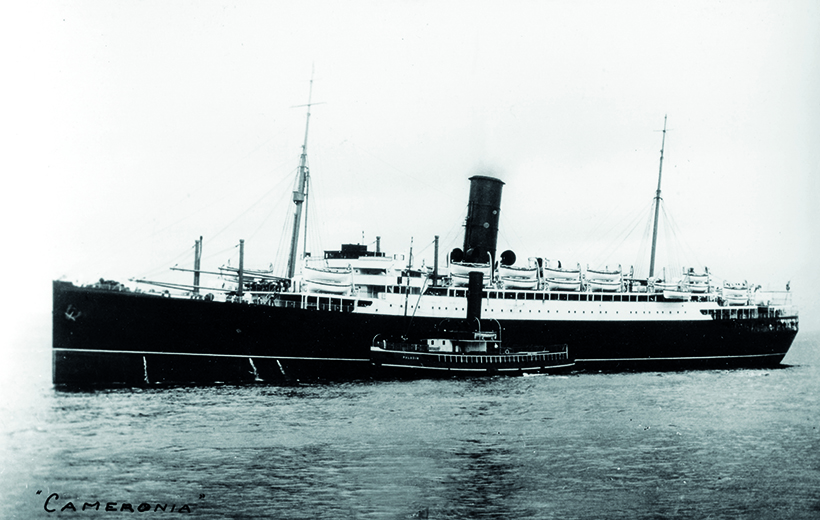
The new Cameronia and the Anchor Line’s tender Paladin (1913) in the River Clyde. (Pic: Ray Woodmore Collection)
Following conversion into a transport, HMT Cameronia first carried troops to Suez in January 1941, and then made multiple trips between Alexandria and Greece. During the first half of 1942 she was in South and East African waters, after which she sailed to Bombay.
Now a Landing Ship Infantry, Cameronia participated in four Allied landings, starting with Operation Torch on November 12th, 1942. Off Algiers on December 22nd, she was hit by an aerial torpedo from a JU-88, which blew a 288ft2 hole in her side and killed 17 on board. She managed to reach Bougie and then Algiers. After temporary patching at Gibraltar, she proceeded to Glasgow.

Photo postcard of Cameronia. (Pic: Author’s collection)
Fully repaired, Cameronia sailed for Malta in June, 1943, and then landed a Canadian Tank Division at Syracuse. She was the largest transport ship at D-Day in June 1944, and also landed troops at St Tropez during Operation Dragoon that August.
On her final transatlantic voyages, Cameronia arrived at Halifax on August 11th, 1945, and at Quebec City on September 10th, carrying returning Canadian Forces. During her war service, Cameronia steamed 321,323 miles and carried 163,789 personnel. She was, like Columbia after World War I; the sole survivor of Anchor’s Atlantic fleet, as California, Transylvania and Caledonia were all war casualties, and Tuscania was sold to the Greeks in 1939. But there was no second revival of Anchor’s Glasgow-New York passenger service.
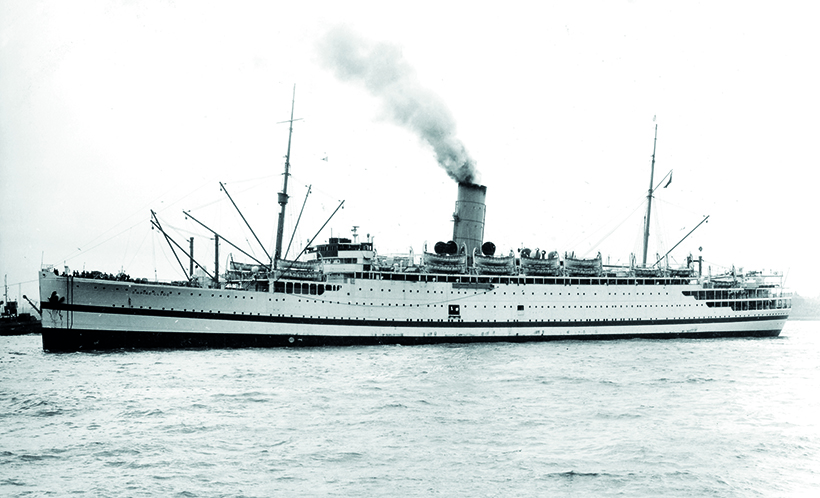
HMT Empire Clyde in her transport livery of white, buff funnel and wide blue sheer line. J.H. Isherwood remarked: ‘Unfortunately her decks were so stepped down aft that [the] blue line was painted too low for good looks, rather giving her the appearance of a lady whose belt has slipped.’ (Pic: Roy Woodmore Collection)
In February 1948, it was announced that Cameronia would be converted into a migrant ship for Australia’s Assisted Passage scheme. At Barclay Curle’s Elderslie yard, she was refitted with a new, slightly shorter funnel, four of her six boilers were replaced, the gap between her bridge and boat deck superstructure filled in and she got new accommodation for 1,246 in 282 two-, four- or six-berth cabins. Her public rooms were refurbished and one was converted into a large nursery. The £500,000 cost of the work was borne by the Australian Government.
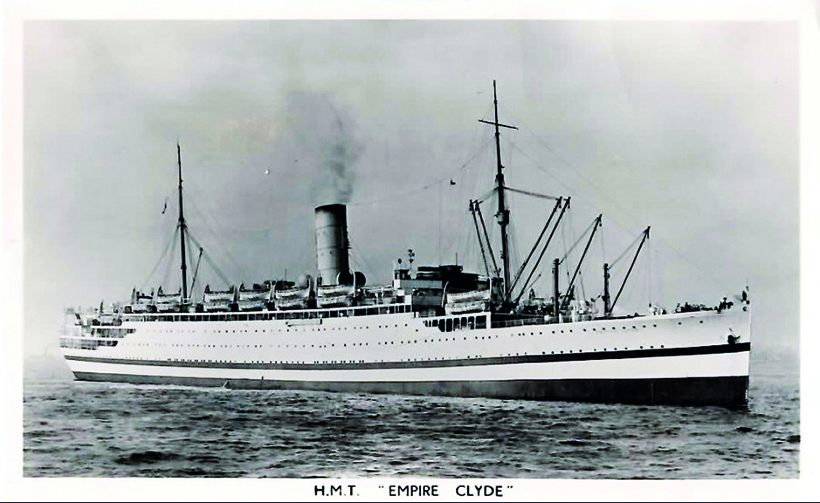
Postcard of HMT Empire Clyde, the most popular of all post-war British troopships, due to her all-private cabin accommodation, carried over from her migrant service. (Pic: Author’s collection)
On November 1st, 1948, Cameronia made her first voyage from Glasgow to Sydney, via Suez, Fremantle and Melbourne. Arriving at Sydney on December 8th, she was heralded as ‘The Queen Mary of the Migrant Fleet’.
She suffered engine trouble after leaving Glasgow on June 1st, 1950, so diverted to Southampton for repairs. Her 1,245 passengers remained on board and she resumed her voyage on June 14th. Making four trips a year, Cameronia completed 11 voyages to Australia, carrying 13,811 migrants up to her final arrival at Sydney on November 9th, 1952.
The Korean War gave Cameronia yet another lease on life, when the Ministry of Transport purchased her for £41,000 on January 9th, 1953, as a transport. Renamed Empire Clyde, her all-private cabin accommodation instantly made her the most popular of all troopships.
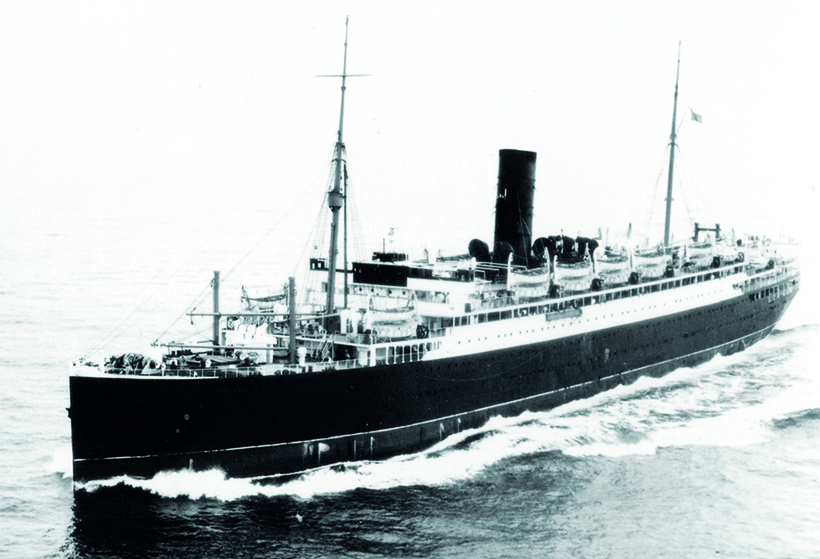
The migrant ship Cameronia: note the Boat Deck, which has been extended to the bridge, and the new, slightly shorter funnel. (Pic: Roy Woodmore Collection)
Rushed into service still in her original livery, and renamed HMT Empire Clyde, she sailed from Liverpool to Malaya on 20 January, 1953. Mostly on the Southampton-Singapore-Hong Kong route, Empire Clyde made at least nine such voyages from 1953 to 1956, often calling en route at Malta, Cyprus and Egypt, as well as making one trip to the West Indies and Bermuda in 1954. Her last voyage was to Christmas Island in July 1957. Her Captain, Alexander C Johnson, and Purser, WA McKay, had both been aboard on her maiden voyage, 35 years earlier.
On September 30th, 1957, Empire Clyde docked at Liverpool. It proved to be her swansong. Finally ringing off ‘Finished With Engines’, the former Cameronia arrived at the Newport, Monmouthshire yard of John Cashmore & Co in March, 1958, to be broken up; 39 years after she had been laid down to begin a new a generation of British Atlantic intermediate liner. None had a better record than hers.
For a money-saving subscription to Ships Monthly magazine, simply click here



